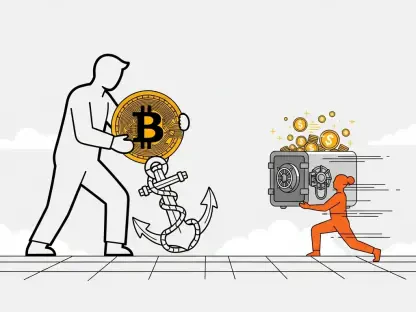Diving into the volatile world of cryptocurrency, we’re thrilled to sit down with Kofi Ndaikate, a seasoned expert in fintech, blockchain, and cryptocurrency markets. With a deep understanding of market trends, regulatory landscapes, and trading dynamics, Kofi offers invaluable insights into Bitcoin’s recent price struggles and what they mean for investors. In this conversation, we explore the factors behind Bitcoin’s dip to around $100,700, the implications of liquidity clusters and support levels, the behavior of futures traders, and the technical risks shaping the market’s direction. Let’s unpack these critical topics and gain a clearer perspective on where Bitcoin might be headed next.
How do you see the recent drop in Bitcoin’s price to about $100,700 impacting the broader market sentiment among investors?
This drop to $100,700, which reflects a roughly 3.5% decline over the past week, is definitely shaking things up. Investors are feeling uneasy, especially since this isn’t just a one-off dip but part of a pattern of volatility. When prices slide like this, you often see a mix of panic selling and cautious optimism—some folks are worried about further losses, while others see it as a buying opportunity. What’s more concerning is the data showing long-term holders offloading over 815,000 BTC in the last 30 days. That kind of selling pressure from people who’ve held for a while can spook the market, making newer investors question whether the bottom is really in.
What’s driving this significant sell-off by long-term Bitcoin holders, and does it point to a larger trend in the market?
The sell-off of over 815,000 BTC by long-term holders is a big red flag. Often, these holders are seen as the bedrock of confidence in Bitcoin’s value, so when they start selling in bulk, it suggests they’re either locking in profits after a price run-up or losing faith in near-term growth. It could also be tied to external factors like macroeconomic uncertainty or changes in personal financial strategies. Whether this is a broader trend depends on if we see this behavior persist—right now, it’s amplifying downside pressure and signaling to the market that even the most steadfast believers might be reevaluating their positions.
Analysts have highlighted a liquidity cluster near $98,000. Can you break down what this means for Bitcoin’s short-term price movement?
A liquidity cluster near $98,000 means there’s a significant amount of buy and sell orders concentrated at that price level, often acting as a magnet for price action. In the short term, if Bitcoin keeps sliding, this level could become a battleground—either buyers step in to defend it, potentially sparking a bounce, or sellers overwhelm the bids, leading to a sharper drop. With nearly $1.3 billion in long leveraged liquidity tied to this zone, a break below could trigger a cascade of liquidations, pushing the price even lower. It’s a critical spot to watch.
Why is there such intense focus on $98,000 as a potential target if volatility increases?
The focus on $98,000 stems from both technical and psychological factors. Technically, it’s near the June 2025 lows, so it’s a historical level where buyers have stepped in before. Psychologically, it’s close to that big round number of $100,000, which traders often fixate on. Plus, the data shows a huge pool of leveraged long positions at this level. If volatility spikes and the price drops there, it could force those positions to liquidate, accelerating the downward move. It’s essentially a high-stakes tipping point right now.
Bitcoin has tested the $100,000 to $102,000 support range multiple times since May 2025. Why does this repeated testing concern analysts?
Repeated testing of a support range like $100,000 to $102,000 is worrying because it often signals weakening buyer conviction. Each time the price dips to this level and bounces, it takes a toll on the resting bid liquidity—there are fewer buyers willing to step in at the same strength. Analysts see this as structural exhaustion; the more a support is tested without a strong breakout above, the higher the chance it eventually gives way. After four tests since May 2025, the risk of a breakdown is growing, and that’s got everyone on edge.
What are the implications for the market structure when a support level is tested this many times?
When a support level is tested repeatedly, the market structure starts to erode at that point. Initially, support levels are where buyers dominate, absorbing selling pressure. But with each test, that dominance fades—buyers get fatigued, and their orders thin out. This can shift the balance toward sellers, turning what was once a floor into a potential ceiling if the level breaks. It also creates uncertainty, as traders start betting on a breakdown rather than a bounce, which can amplify volatility. If this $100,000 to $102,000 range fails, we could see a rapid shift in sentiment.
Despite the risks, futures traders are heavily positioned on the long side. What’s motivating them to bet on a price increase right now?
Futures traders leaning heavily long, with about 68.9% of global Bitcoin orders on Binance favoring upside, are likely driven by a mix of optimism and stubbornness. Many probably believe $100,000 is a psychological floor that won’t break easily, or they’re banking on a quick recovery to levels like $108,000. Some might also be caught in a trap—holding leveraged positions they can’t afford to close at a loss. But it’s risky, especially with technical indicators showing softness on higher time frames. They’re betting against the current momentum, which could backfire if downside pressure builds.
With $1.3 billion in long leveraged liquidity at $98,000, what could unfold if Bitcoin’s price falls to that level?
If Bitcoin drops to $98,000, that $1.3 billion in long leveraged liquidity could ignite a brutal chain reaction. Leveraged longs mean traders have borrowed heavily to bet on a price rise, and if the price hits that level, many of those positions could be forcibly liquidated by exchanges to cover losses. This would flood the market with sell orders, driving the price down even further in a matter of minutes. It’s often called a “liquidity sweep,” and it can create a domino effect, wiping out billions in value and shaking confidence across the board.
Some analysts describe the recent price action as a failed breakout. Can you explain what they mean and why it matters?
A failed breakout happens when the price tries to push above a key resistance level but can’t sustain the momentum and falls back below it. In Bitcoin’s case, analysts are likely referring to attempts to break past levels like $106,000 or higher, only to retreat below critical support zones. This matters because it shows a lack of buying power to drive a sustained rally—it’s a sign of weakness. Traders often see this as a bearish signal, indicating that sellers are still in control and that lower levels might be tested soon. It’s a warning that bullish hopes aren’t backed by market strength right now.
Looking ahead, what’s your forecast for Bitcoin’s price trajectory in the coming weeks given these dynamics?
Forecasting Bitcoin’s price is always tricky, but based on current dynamics, I think we’re in for more turbulence in the coming weeks. The $98,000 level is a critical threshold—if it holds, we could see a bounce back toward $102,000 or even $108,000 as confidence rebuilds. But if it breaks, especially with that $1.3 billion in leveraged positions at risk, we might see a sharp drop, potentially testing levels closer to $90,000. The repeated support tests and long-term holder selling add to the downside risk, while heavy long positioning in futures shows there’s still some bullish hope. I’d say keep a close eye on volume and volatility—those will tell us which way the market’s mood swings next.









